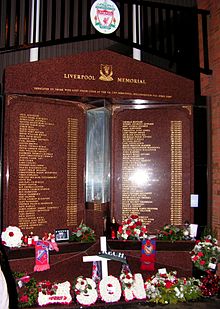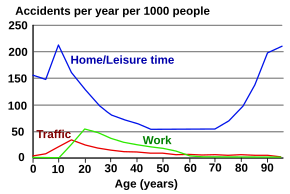Accident

An accident is an unintended, normally unwanted event that was not directly caused by humans.
Types

Physical and non-physical
Physical examples of accidents include unintended motor vehicle collisions, tongue biting while eating, electric shock by accidentally touching bare electric wire, drowning, falls, being injured by touching something sharp or hot, or bumping into something while walking.
Non-physical examples are unintentionally revealing a
Accidents by activity
- Accidents during the execution of work or arising out of it are called work accidents. According to the International Labour Organization (ILO), more than 337 million accidents happen on the job each year, resulting, together with occupational diseases, in more than 2.3 million deaths annually.[4]
- In contrast, leisure-related accidents are mainly sports injuries.
Accidents by vehicle

This section needs expansion with: data on vehicular collisions. You can help by adding to it. (December 2023) |
It has been argued by some critics that vehicle collisions are not truly accidents, given that they are mostly caused by preventable causes such as drunk driving and intentionally driving too fast, and as such should not be referred to as accidents.[3] Since 1994, the US National Highway Traffic Safety Administration has asked media and the public to not use the word accident to describe vehicle collisions.[3]
Aviation accidents and incidents
This section needs expansion. You can help by adding to it. (December 2023) |
Bicycle accidents
This section needs expansion. You can help by adding to it. (December 2023) |
Maritime incidents
This section needs expansion. You can help by adding to it. (December 2023) |
Traffic collisions
This section needs expansion. You can help by adding to it. (December 2023) |
Train wrecks
This section needs expansion. You can help by adding to it. (December 2023) |
Domino effect accidents
In the process industry, a primary accident may propagate to nearby units, resulting in a chain of accidents, which is called domino effect accident.
Common causes

Poisons, vehicle collisions and falls are the most common causes of fatal injuries. According to a 2005 survey of injuries sustained at home, which used data from the National Vital Statistics System of the United States National Center for Health Statistics, falls, poisoning, and fire/burn injuries are the most common causes of death.[5]
The United States also collects statistically valid injury data (sampled from 100 hospitals) through the National Electronic Injury Surveillance System administered by the
Accident models

Many models to characterize and analyze accidents have been proposed,[10] which can be classified by type. No single model is the sole correct approach.[11] Notable types and models include:[12]
- Sequential models
- Complex linear models
- Energy damage model[14][full citation needed]
- Time sequence models
- Generalized time sequence model[15][full citation needed]
- Accident evolution and barrier function[16]
- Epidemiological models
- Gordon 1949[citation needed]
- Onward mappings model based on resident pathogens metaphor[17]
- Process model
- Benner 1975[citation needed]
- Systemic models
- Rasmussen
- Reason model of system safety (embedding the Swiss cheese model)
- Woods 1994[citation needed]
- Non-linear models
- System accident[18]
- Systems-theoretic accident model and process (STAMP)[19]
- Functional resonance analysis Method (FRAM)[20]
- Assertions that all existing models are insufficient[21][full citation needed]
See also
General
- Occupational safety and health
- Safety
- Personal protective equipment
- Safety engineering
- Fail-safe
- Idiot-proof
- Poka-yoke
- Risk management
- Accident analysis
- Accident-proneness
- Injury
- List of accidents and disasters by death toll
Transportation
- Bicycle safety
- Road vehicle safety
- Automobile safety
- Traffic collision
- List of rail accidents
- Tram accident
- Maritime incident
- Air safety
Other specific topics
- Aisles: Safety and regulatory considerations
- Explosives safety
- Nuclear and radiation accidents
- Sports injury
References
- ISBN 978-0-7391-7905-5.
Since 'accidents' by definition deprive us of first-order human causes…
- ^ Robertson, Leon S. (2015). Injury Epidemiology: Fourth Edition. Lulu Books. Archived from the original on 2018-01-26. Retrieved 2017-12-09.
- ^ a b c Stromberg, Joseph (2015-07-20). "We don't say "plane accident." We shouldn't say "car accident" either". Vox. Archived from the original on 2021-09-07. Retrieved 2021-09-07.
- ^ "ILO Safety and Health at Work Archived 2022-01-19 at the Wayback Machine". International Labour Organization (ILO)
- PMID 15626560.
- ^ a b CPSC. National Electronic Injury Surveillance System (NEISS) Archived 2013-03-13 at the Wayback Machine. Database query available through: NEISS Injury Data Archived 2013-04-23 at the Wayback Machine.
- ^ NCHS. Emergency Department Visits Archived 2017-07-11 at the Wayback Machine. CDC.
- ^ "Injuries, Illnesses, and Fatalities". www.bls.gov. Archived from the original on 2019-06-02. Retrieved 2014-04-02.
- ^ a b H.W. Heinreich (1931). Industrial Accident Prevention. McGraw-Hill.
- ISBN 0750661976.
- ISBN 978-1-4987-3666-4.
- ISBN 978-0-9808743-1-0. Archived(PDF) from the original on 2017-02-25. Retrieved 2017-03-25.
- OCLC 858460141.
- ^ Gibson, Haddon, Viner
- ^ Viner
- PMID 1947355.
- ^ Reason, James T. (1991). "Too Little and Too Late: A Commentary on Accident and Incident Reporting". In Van Der Schaaf, T.W.; Lucas, D.A.; Hale, A.R. (eds.). Near Miss Reporting as a Safety Tool. Butterworth-Heinemann. pp. 9–26.
- ISBN 978-0465051434.
- .
- ^ Hollnagel, 2012
- ^ Dekker 2011
External links
